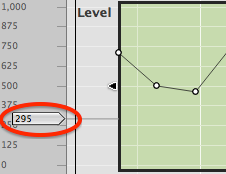Recording Automation
To quickly create automation data, it is sometimes easiest to
record your knob-turning or slider-dragging action in real time.
You can fine-tune this data later. This is a good way of doing it,
because you can try out your moves while playing the sequence to
hear the effect of the changes before recording them.
The steps below show how to automate a slider in the SubTractor
instrument, but the procedure is the same for any control (knob or
slider) in any of the Instrument or Effect devices.
- Create an instance of the SubTractor instrument in your
rack.
- Right-click directly on the Filter 1 Freq slider in
SubTractor, and choose Edit Automation from the
context menu.
This creates, in the SubTractor sequencer track, a lane for
the Filter Freq parameter, shown in the image below.
When recording automation, be sure to select the track for
the appropriate device, so that your automation changes will
go into that track.
- Set the Position Pointer in the Sequencer to an appropriate
place, and press Record.
- Drag the Filter 1 Freq slider up and down. These changes in
filter cutoff frequency will appear in a new automation clip
in the lane created in step 1.
- That’s it! When you play this part of the sequence,
you’ll see the slider move by itself.
Notice that the automation lane has an M button (circled in
red below). You can use this to mute automation playback
temporarily. If you click the M button so that it turns red
and white, the automation will not play back. Every track has a
Record Enable Parameter Automation button (circled in blue
below). This must be on (red) before you can record automation into
the track.





